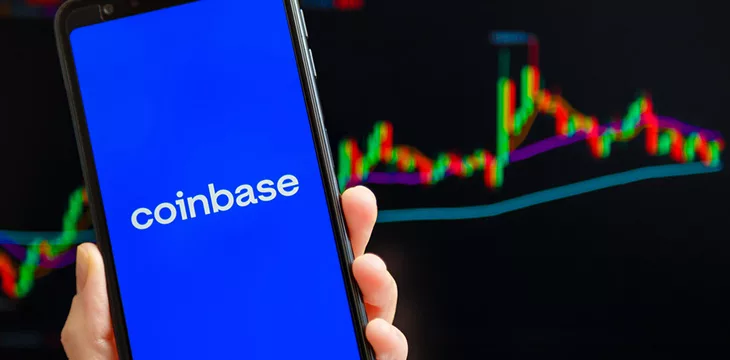|
Getting your Trinity Audio player ready...
|
Coinbase (NASDAQ: COIN) came within a whisker of breaking even in the third quarter, but it wasn’t because traders were flooding back to the struggling digital asset exchange.
Figures released Thursday showed Coinbase generated revenue of $674 million in the three months ending September 30, a 4.8% fall from Q2’s result but a 14.1% improvement from the same period last year. However, an $82 million gain from its recent debt buyback program and a 3.5% fall in operating expenses resulted in a comparatively mild net loss of $2.2 million for the quarter. Regardless, this marks the seventh consecutive quarter in which Coinbase has failed to turn a profit.
Revenue generated from customer transaction fees totaled $288.4 million, down nearly 12% sequentially and 21% below Q3 2022. Both consumer ($274.5 million, -11.4%) and institutional ($14.1 million, -17.5%) transaction revenue were down from Q2, an uninterrupted 2023 trend the company blamed on digital asset volatility being “the lowest level we have measured since 2016.”
Trading volume was also down across the board, with retail off more than one-fifth to $11 billion, while institutional volume fell nearly 17% to $65 billion. The BTC token remained king with 38% of all volume (-2 points), while ETH fell four points to 19% and ‘other crypto assets’ sank 10 points to 28%.
For the first time—and this is really bad timing given the current antagonistic mood toward Tether on Capitol Hill—Coinbase revealed that Tether’s USDT stablecoin was involved in 15% of all trades on the exchange in Q3. Coinbase claimed USDT volume “was elevated temporarily across the entire industry, including on Coinbase, largely due to de-pegging events.” (CoinGecko data shows USDT’s top trading pairs on Coinbase are USD, EUR, and BTC.)
This ‘temporary’ elevation followed the unfortunate swoon that Circle’s USDC stablecoin took this spring after the failure of Silicon Valley Bank (SVB), where Circle had unwisely parked $3.3 billion of USDC’s reserve assets in a single account. USDC briefly lost its 1:1 peg with the U.S. dollar, trading below 90¢ at one point before the big bad government that ‘crypto’ was supposed to overthrow stepped in with a financial bailout, and the peg was restored.
New USDC deal paying off
Speaking of USDC, it accounted for one of the few improving verticals in Coinbase’s Q3 report. ‘Stablecoin revenue,’ a new category previously lumped in with interest income, totaled $172.4 million compared with $151.4 million in Q2. USDC balances on Coinbase rose to $2.5 billion at the end of Q3 compared with $1.8 billion as of June 30.
The new category reflects the revised agreement Coinbase and Circle struck in August following the demise of their USDC-overseeing Centre ‘consortium.’ Details of this new deal were opaque, but Coinbase said Thursday that it “will earn a pro-rata portion of income earned on the USDC reserves based on the amount of USDC held on each respective party’s platform, and will now equally share in the income earned from the distribution and usage of USDC after certain expenses.”
The positive result from this shift is impressive, considering that USDC’s market cap continues to shrink like George Costanza in a cold swimming pool. USDC’s cap shrunk again on Thursday, falling nearly half a billion to below $24.4 billion, around $20 billion below its cap at the start of 2023.
Coinbase also saw gains in its ‘corporate interest and other income’ segment, which rose 12.5% to $51.1 million, while ‘other subscription and services revenue’ gained 10% to $32.3 million. But blockchain rewards ($74.5 million, -15%), interest income ($39.5 million, -21%), and custodial fees ($15.8 million, -7%) erased those gains, leaving the overall ‘subscription and services’ category flat at $334.4 million.
Corner offices are the new champagne rooms
As for costs, the biggest improvement came via transaction expenses, which fell 16% from Q2 due to lower staking rewards paid out to customers. However, Coinbase doled out another $219 million in stock-based compensation, which it claims was “in line with our outlook.”
In case you were wondering, that outlook appears to be ‘screw the shareholders, and never mind seven straight quarters of net losses, we’ve got executives who might jump ship and lose money at some other company if we don’t keep them fat and happy.’ Coinbase currently projects ‘only’ $164 million in stock giveaways in the current quarter, but that will push the 2023 total close to $900 million.
Coinbase continues to struggle to coax customers back into the trading arena. Its monthly transacting users (MTUs) through the first nine months of 2023 were 7.5 million, a 16% decline from the same point last year. (And remember, Coinbase includes ‘passive’ users—those whose only activity is receiving a staking reward—in its MTU stats.) Institutional MTU trading volume fell by half to $267 billion, while retail MTU volume plunged 69% to just $46 billion.
Looking ahead, Coinbase says it generated $105 million in transaction revenue in October, but subscription and services revenue is expected to be flat in Q4.
Coinbase shares closed Thursday up nearly nine percent to $84.60, its best showing in a month. However, that remains a fraction of the $357 peak following Coinbase’s April 2021 Nasdaq debut, and Thursday’s after-hours trading saw the price fall back below $81.
Don’t mention the stables
Incredibly, despite the obvious significance of USDC to Coinbase’s bottom line and the new disclosures regarding its Tether volume, CEO Brian Armstrong didn’t face a single question regarding stablecoins on Thursday’s analyst call. Pity, because we hoped someone would ask how Coinbase’s ‘revolutionizing finance’ mantra squared with the exchange becoming critically dependent on the interest generated from fiat deposits and money market funds.
There were questions about Coinbase’s dwindling transaction volume, with retail numbers at record lows. A couple of analysts asked if Coinbase would continue to tinker with its fee structure to squeeze more blood out of these stones. Chief Financial Officer Alesia Haas said the company would continue its “experimentation” to see “what works for customers,” claiming that the exchange raised its fee spread in Q1 without any significant change in customer activity (a claim perhaps belied by the ongoing lack of trading activity).
As for Coinbase’s new proprietary Ethereum-based ‘Layer 2’ network Base, the monetization question raised its ugly head again. At present, Coinbase is the only ‘sequencer’ aka transaction validator on Base, and these ‘sequencing’ fees are now included in the overall transaction revenue segment. But Base fees are still “not material enough” to break out as a separate category.
Armstrong claimed that only 7% of all digital asset transactions were currently taking place on Layer 2 networks, something he hopes Base will change. With Base boasting “more than one million transacting wallets over the last month,” Armstrong wants to “make Layer 2 the default” transaction platform. (This is the type of argument you’re left with when you choose to ignore blockchains that offer a robust and infinitely scalable base (not Base) layer.)
As for the new Bermuda-based, derivatives-focused Coinbase International exchange, the platform did $10 billion in “notional volume” in Q3, which Armstrong called “a good start but still relatively small.” There were hopes that the exchange could soak up some of the derivative action left stranded by last year’s collapse of FTX, but it seems traders prefer the wild west of Binance to the comparatively compliant Coinbase.
Wrap your bald head around this
There was an hour-and-a-half last month in which it seemed that Rep. Tom Emmer (R-MN) could end up as the new speaker of the House of Representatives. But Emmer, a major ‘crypto’ advocate who once publicly lauded Sam Bankman-Fried for “doing a lot to make sure there is no fraud or other manipulation” in the digital asset sector, was turfed even before a vote was taken.
The new speaker, Mike Johnson (R-LA), has an ‘unclear’ designation on Coinbase’s ‘crypto sentiment’ scorecard, leaving Armstrong & Co. a lot less clear on how favorable digital asset legislation might fare in the House. Armstrong acknowledged Thursday that “D.C. has a crisis coming up every week” and “we don’t pretend to be the top issue for everybody at all times.” Even more so given that Congress is heading into what promises to be a raucous election year.
But Armstrong may have doomed whatever faint hopes remain by claiming that most politicians belong to “an older generation” who haven’t used digital assets and “they don’t use e-commerce either, right? Sometimes, they have a little trouble wrapping their head around it.” Um, Brian… you know this conversation is being recorded, right?
Follow CoinGeek’s Crypto Crime Cartel series, which delves into the stream of group—from BitMEX to Binance, Bitcoin.com, Blockstream, ShapeShift, Coinbase, Ripple, Ethereum,
FTX and Tether—who have co-opted the digital asset revolution and turned the industry into a minefield for naïve (and even experienced) players in the market.

 12-15-2025
12-15-2025 





